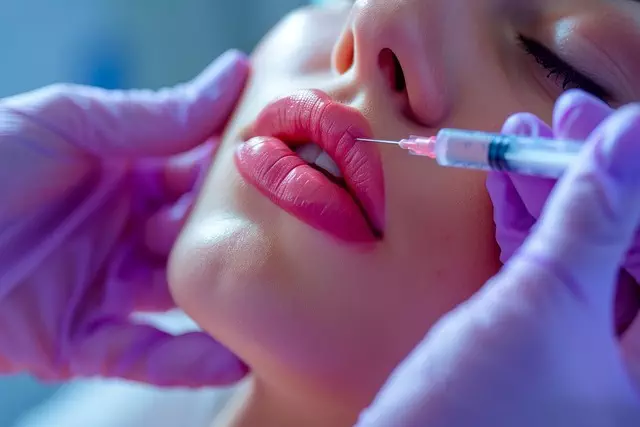Chronic migraines, characterized by recurring severe headaches, are linked to facial nerve issues and brain chemistry shifts. Botox, primarily known for cosmetic uses, offers a dual benefit: relaxing muscles associated with pain to reduce migraine frequency and intensity, while also slimming the jawline by targeting specific facial muscles. This non-invasive treatment is endorsed by the American Headache Society for chronic migraine prevention and has proven effective in treating tension headaches and jaw clenching. Beyond aesthetics, Botox shows potential in neurology, including managing Parkinson's disease and dystonia. Safety profiles and reversible effects make it an attractive option for diverse therapeutic applications.
“Unraveling the potential of Botox as a game-changer in chronic migraine management, this comprehensive guide explores its multifaceted benefits. Chronic migraines, characterized by frequent and debilitating attacks, affect millions. Understanding their causes and symptoms is crucial. This article delves into how Botox, beyond its popular jawline slimming uses, offers a non-invasive solution to reduce migraine frequency. We examine its mechanism of action, safety considerations, and inspiring patient success stories, while also glancing into the future of Botox’s role in neurology.”
Understanding Chronic Migraines: Causes and Symptoms

Chronic migraines are a complex condition characterized by recurring headaches that can last from several days to even months. Unlike typical migraines, which often have distinct triggers and symptoms, chronic migraines may not always follow a clear pattern. They are defined as 15 or more days of headache per month for at least three months, with each headache lasting at least one hour. Symptoms vary but commonly include severe throbbing pain, sensitivity to light and sound, nausea, and sometimes visual disturbances. The exact causes are not fully understood, but they are believed to involve a combination of genetic predisposition, environmental factors, and changes in brain chemistry.
One notable aspect of chronic migraines is their association with facial nerve issues, particularly in the jawline area. This connection has led many healthcare professionals to explore treatments like Botox for potential relief. The benefits of Botox go beyond jawline slimming; it can help reduce headache frequency and intensity by relaxing muscles that contribute to migraine pain. Understanding these underlying causes and symptoms is crucial when considering therapeutic options, including non-invasive procedures like Botox injections.
The Role of Botox in Migraine Management

Botox, primarily known for its role in cosmetic procedures, has emerged as a promising treatment option for chronic migraines. Beyond its aesthetic applications, Botox offers several potential benefits for individuals struggling with frequent and severe headaches. The injection directly targets specific muscle groups in the head and neck, including those involved in migraine episodes. By relaxing these muscles, Botox can help reduce the frequency and intensity of migraines, providing much-needed relief to patients.
One lesser-discussed advantage of Botox is its capacity for jawline slimming, which has indirect benefits for migraine management. Tension in facial muscles, particularly around the jaw, can contribute to headaches. Botox injections can ease this tension, potentially alleviating some of the symptoms associated with migraines. This dual action—muscle relaxation and jawline slimming—makes Botox a versatile treatment for both aesthetic concerns and chronic migraine conditions.
Benefits of Botox for Jawline Slimming

Botox isn’t just a popular choice for reducing facial wrinkles; it offers significant advantages in slimming the jawline, providing a non-surgical alternative to cosmetic procedures. The benefits extend beyond aesthetics, as many individuals seeking jawline slimming also aim to alleviate chronic migraines and tension headaches. By relaxing specific muscle groups, Botox can help reduce the frequency and intensity of these debilitating headaches, making it a valuable tool for migraine management.
Moreover, the non-invasive nature of Botox treatments makes it an appealing option for those who prefer not to undergo surgery or are looking for temporary yet effective solutions. Jawline slimming achieved through Botox not only enhances facial symmetry and balance but also contributes to a more relaxed and confident appearance. This procedure is particularly beneficial for people experiencing muscle tightness or asymmetry in the jaw area, which can be both painful and contribute to headaches.
How Botox Works to Reduce Migraine Frequency

Botox, a protein derived from bacteria, has gained recognition as an effective treatment for chronic migraines. Its mechanism of action involves relaxing muscles and reducing nerve impulses that contribute to migraine pain. When injected into specific areas of the head, neck, and jawline, Botox can significantly decrease the frequency and intensity of migraines over time.
One of the lesser-known benefits of Botox is its ability to slim the jawline. By targeting facial muscles responsible for chewing and biting, Botox injections can soften these muscles, leading to a more defined and slender jawline. This aesthetic advantage adds to the growing list of reasons why individuals are exploring Botox as a solution not just for migraines but also for enhancing their overall appearance.
Non-Invasive Treatment Option for Chronic Migrainers

For chronic migraine sufferers, finding relief that doesn’t involve invasive procedures can be a game-changer. Botox, a popular non-surgical treatment option, offers a promising avenue for managing this debilitating condition. Beyond its well-known effects on facial aesthetics, Botox is increasingly recognized for its potential to alleviate migraines.
One less-explored benefit of Botox involves jawline slimming and the positive impact it can have on migraine symptoms. By relaxing specific muscle groups, Botox can reduce tension in the head and neck area, which is often a trigger for chronic migraines. This non-invasive approach not only provides aesthetic advantages but also contributes to overall comfort and quality of life for those plagued by frequent headaches.
Safety and Efficacy Considerations for Botox in Migraines

When considering Botox as a treatment for chronic migraines, it’s essential to weigh the benefits against potential safety and efficacy concerns. Several studies have shown that Botox can significantly reduce migraine frequency and intensity in eligible patients. The American Headache Society has recognized Botox as a safe and effective option for chronic migraine prevention when administered by qualified healthcare providers.
One of the advantages often discussed regarding Botox injections is their potential to offer benefits beyond migraine relief, such as jawline slimming. This can be particularly appealing to individuals who also struggle with facial aesthetic concerns. However, it’s crucial to consult a medical professional who specializes in Botox treatments for migraines and cosmetic procedures to ensure safety and achieve desired outcomes. They can provide personalized guidance based on your specific condition and aesthetic goals.
Patient Stories: Success with Botox for Chronic Migraines

Many patients suffering from chronic migraines have found relief and a significant improvement in their quality of life through the use of Botox. These success stories highlight the growing acceptance of Botox as a treatment option for migraine management. One patient, Sarah, shared her experience, stating, “I used to have debilitating headaches almost daily, but since starting Botox treatments, I’ve noticed a dramatic decrease in their frequency and intensity.”
Additionally, some patients have also experienced the beneficial side effect of jawline slimming as an added perk. This is particularly relevant for individuals who suffer from tension headaches or jaw clenching, which can contribute to chronic migraines. The non-invasive nature of Botox and its ability to relax facial muscles offer a new perspective on migraine treatment, providing both pain relief and aesthetic benefits, especially in terms of slimming the jawline.
Future Outlook: Evolving Uses of Botox in Neurology

As research continues to uncover the versatile applications of Botox, the future looks promising for its role in neurology beyond aesthetic purposes. Beyond its established benefits for chronic migraine management and jawline slimming, there’s growing evidence suggesting its potential in treating other neurological conditions.
Scientists are exploring Botox’s ability to modulate nerve signals, offering hope for managing movement disorders like Parkinson’s disease and dystonia. Its safety profile and gradual, reversible effects make it an attractive option for clinical trials investigating new avenues of treatment. This evolving landscape suggests that Botox could become a valuable tool in neurology, expanding its use cases and further improving patient outcomes.
